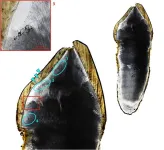Exposure to even moderate levels of radon linked to increased risk of stroke
2024-01-31
(Press-News.org) EMBARGOED FOR RELEASE UNTIL 4 P.M. ET, WEDNESDAY, JANUARY 31, 2024
MINNEAPOLIS – Radon is the second leading cause of lung cancer. Now a new study has found exposure to this invisible, odorless gas is also linked to an increased risk of stroke. The study, which examined exposures in middle age to older female participants, found an increased risk of stroke among those exposed to high and even moderate concentrations of the gas compared to those exposed to the lowest concentrations. The study is published in the January 31, 2024, online issue of Neurology®, the medical journal of the American Academy of Neurology. The study does not prove that exposure to radon causes stroke; it only shows an association.
Radon is a naturally occurring radioactive gas produced when metals like uranium or radium break down in rocks and soil. The gas can make its way into homes through cracks in basement walls and floors, construction joints and gaps around pipes.
“Radon is an indoor air pollutant that can only be detected through testing that measures concentrations of the gas in homes,” said study author Eric A. Whitsel, MD, MPH, of the University of North Carolina in Chapel Hill. “Our research found an increased risk of stroke among participants exposed to radon above —and as many as two picocuries per liter (pCi/L) below — concentrations that usually trigger Environmental Protection Agency recommendations to install a home radon mitigation system.”
The study involved 158,910 female participants with an average age of 63 who did not have stroke at the start of the study. They were followed for an average of 13 years. During the study, there were 6,979 strokes among participants.
To determine radon exposures, researchers linked participants’ home addresses to radon concentration data from the U.S. Geological Survey and the U.S. Environmental Protection Agency (EPA).
The EPA recommends that average indoor radon concentrations do not exceed four picocuries per liter (pCi/L). For concentrations this high, the EPA recommends installing a radon mitigation system to lower radon levels in the home.
Participants were divided into three groups. The highest group had homes in areas where average radon concentrations were more than four pCi/L. The middle group lived in areas with average concentrations between two and four pCi/L. The lowest group lived in areas with average concentrations of less than two pCi/L.
In the group with the highest radon exposures, there were 349 strokes per 100,000 person-years compared to 343 strokes in the middle group and 333 strokes in group with the lowest exposure. Person-years represent both the number of people in the study and the amount of time each person spends in the study.
After adjusting for factors such as smoking, diabetes and high blood pressure, researchers found participants in the highest group had a 14% increased risk of stroke compared to those in the lowest group. Those in the middle group had a 6% increased risk.
“It’s important to note that we found an increased stroke risk among those exposed to radon concentrations as much as two pCi/L below the current lung cancer-based threshold for recommending radon mitigation,” said Whitsel. “More studies are needed to confirm our findings. Confirmation would present an opportunity to improve public health by addressing an emerging risk factor for stroke.”
A limitation of the study was that it included only female participants who were middle age or older and primarily white, so the results may not be the same for other populations.
The study was funded by the National Institute of Environmental Health Sciences and National Heart, Lung, and Blood Institute.
Learn more about stroke at BrainandLife.org, home of the American Academy of Neurology’s free patient and caregiver magazine focused on the intersection of neurologic disease and brain health. Follow Brain & Life® on Facebook, Twitter and Instagram.
When posting to social media channels about this research, we encourage you to use the hashtags #Neurology and #AANscience.
The American Academy of Neurology is the world’s largest association of neurologists and neuroscience professionals, with over 40,000 members. The AAN is dedicated to promoting the highest quality patient-centered neurologic care. A neurologist is a doctor with specialized training in diagnosing, treating and managing disorders of the brain and nervous system such as Alzheimer’s disease, stroke, migraine, multiple sclerosis, concussion, Parkinson’s disease and epilepsy.
For more information about the American Academy of Neurology, visit AAN.com or find us on Facebook, Twitter, Instagram, LinkedIn and YouTube.
END
ELSE PRESS RELEASES FROM THIS DATE:
2024-01-31
EMBARGOED FOR RELEASE UNTIL 4 P.M. ET, WEDNESDAY, JANUARY 31, 2024
MINNEAPOLIS – People with polycystic ovary syndrome may be more likely to have memory and thinking problems in middle age, according to new research published in the January 31, 2024, online issue of Neurology®, the medical journal of the American Academy of Neurology. The study does not prove that polycystic ovary syndrome causes cognitive decline. It only shows an association.
Polycystic ovary syndrome is a hormonal disorder that is defined by irregular menstruation and elevated levels of a hormone called androgen. Other symptoms may include excess hair growth, acne, infertility and poor metabolic ...
2024-01-31
Rochester Institute of Technology scientists will be the lead researchers on a $1.8 million NASA grant to study electromagnetic signals from merging supermassive black holes.
RIT’s Manuela Campanelli, Distinguished Professor in the School of Mathematics and Statistics and director of the Center for Computational Relativity and Gravitation, will lead the collaborative project with help from Yosef Zlochower, professor in the School of Mathematics and Statistics. The project will also include researchers from the University of Idaho, Johns Hopkins University, and the Goddard Space Flight Center.
The team will combine astrophysical knowledge with state-of-the-art ...
2024-01-31
Indiana University researchers in the College of Arts and Sciences in Bloomington have identified a missing link that can help protect the brain from aging.
Hui-Chen Lu, professor and director of the Linda and Jack Gill Center for Biomolecular Science at IU, alongside graduate students Sen Yang and Zhen Xian Niou, found that nicotinamide nucleotide adenylyl transferase 2, or NMNAT2, provides energy to axons independent of the mitochondria. It does this by propelling glycolysis, a process in which glucose is broken down to produce energy. This gives axons enough energy to ...
2024-01-31
AURORA, Co. (January 31, 2024) - A collaborative cohort of researchers, led by University of Colorado Anschutz Medical Campus professor Angelo D’Alessandro, have identified kynurenine as a critical new biomarker in the quality of stored red blood cells (RBCs), a crucial step in the development of more personalized transfusions. Study results published today in the journal Blood.
The transfusion of RBCs is one of the most common in-hospital medical procedures second only to vaccination. The blood supply is dependent on altruistic blood donors, and donated RBCs are stored ...
2024-01-31
In a new study, 38 percent of dog owners surveyed in Denmark reported giving their pups cannabinoids, particularly cannabidiol or CBD. Pernille Holst and colleagues at the University of Copenhagen, Denmark present these findings in the open-access journal PLOS ONE on January 31.
Cannabis has become popular for recreational and medical use in humans, and many cannabis-based products are also available for pets. But because cannabis is not legal for veterinary use in countries such as Denmark, pet owners are using it without a prescription. To understand how common unlicensed cannabinoid use for pets is in Denmark, Holst and colleagues distributed an anonymous ...
2024-01-31
After big shocks such as the pandemic lockdowns and the invasion of Ukraine, happiness levels may return to normal in as little as 2-3 weeks, per sentiment analysis of tweets in ten countries
###
Article URL: https://journals.plos.org/plosone/article?id=10.1371/journal.pone.0295896
Article Title: Reactions to macro-level shocks and re-examination of adaptation theory using Big Data
Author Countries: South Africa, New Zealand
Funding: The authors received no specific funding for this work. END ...
2024-01-31
Non-invasive wearable devices might be able to predict preterm birth by monitoring changes in maternal heart rate variability
###
Article URL: https://journals.plos.org/plosone/article?id=10.1371/journal.pone.0295899
Article Title: Wearable-derived maternal heart rate variability as a novel digital biomarker of preterm birth
Author Countries: USA
Funding: The authors received no specific funding for this work. END ...
2024-01-31
Evidence from teeth reveals that vitamin D deficiency during childhood was likely a major issue in industrialized England, according to a study published January 31, 2024 in the open-access journal PLOS ONE by Anne Marie Snoddy of the University of Otago, New Zealand and colleagues.
The 18th and 19th centuries AD were a period of industrialization and urbanization in England. This was also a time of increasing incidence of health issues like vitamin D deficiency (VDD) and associated conditions like rickets, potentially linked to changing social practices ...
2024-01-31
Rickets ran rife in children following the Industrial Revolution, but University of Otago-led research has found factory work and polluted cities aren’t entirely to blame for the period’s vitamin D deficiencies.
In a Marsden funded study, just published in PLOS One, researchers from Otago, Durham University, University of Edinburgh, University of Brighton, and University of Queensland, sampled teeth from a cemetery site in industrial era England, looking for microscopic markers of nutritional disease.
Lead author Dr Annie Sohler-Snoddy, Research ...
2024-01-31
NEW YORK, NY (January 31, 2024) – The New York Stem Cell Foundation (NYSCF) announced today that, following a nationwide search, its Board of Directors has named Hunter College President Emerita Jennifer J. Raab as its next President and Chief Executive Officer, effective this month.
NYSCF is one of the world’s leading nonprofit stem cell organizations, raising and investing more than $450 million since its founding in 2005 to accelerate cures for the major diseases of our time through stem cell research. The foundation conducts its own pioneering research at the NYSCF Research Institute laboratories in Manhattan, informs and convenes scientists and ...
LAST 30 PRESS RELEASES:
[Press-News.org] Exposure to even moderate levels of radon linked to increased risk of stroke






